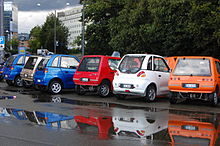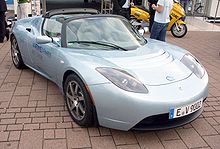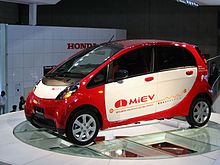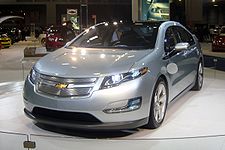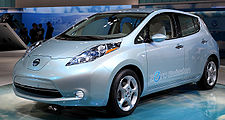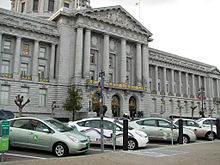- Government incentives for plug-in electric vehicles
-
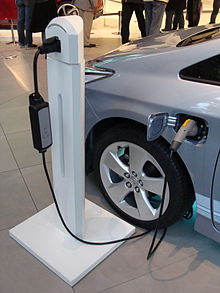 Plug-in electric vehicles subject to incentives in some countries include battery electric vehicles, plug-in hybrids and electric vehicle conversions.
Plug-in electric vehicles subject to incentives in some countries include battery electric vehicles, plug-in hybrids and electric vehicle conversions.
Government incentives for plug-in electric vehicles have been established by several national and local governments around the world as a financial incentive for consumers to purchase a plug-in electric vehicle. The amount of these incentives usually depends on battery size and the vehicle all-electric range, and some countries extend the benefits to fuel cell vehicles, and electric vehicle conversions of hybrid electric vehicles and conventional internal combustion engine vehicles.
Contents
Canada
Ontario established a rebate between CAD 5,000 (4 kWh battery) to CAD 8,500 (17 kWh or more) (~US$5,050 to US$8,650), depending on battery size, for purchasing or leasing a new plug-in electric vehicle after July 1, 2010. The rebates will be available to the first 10,000 applicants who qualify.[1][2] The province will also introduce green-coloured licence plates for exclusive use of plug-in hybrids and battery electric vehicles.[1][3][4] These unique green vehicle plates will allow PEV owners to travel in the province's carpool lanes until 2015 regardless of the number of passengers in the vehicle. Also, owners are eligible to use recharging stations at GO Transit and other provincially-owned parking lots.[1][4]
Quebec will offer rebates of up to CAD 8,500 (US$8,650) beginning on January 1, 2012, for the purchase of new plug-in electric vehicles equipped with a minimum of 4 kWh battery, and new hybrid electric vehicles are eligible for a CAD 1,000 rebate. All-electric vehicles with high-capacity battery packs will be eligible for the full C$8,000 rebate, and incentives are reduced for low-range electric cars and plug-in hybrids. Quebec's government earmarked CAD 50 million (US$52.3 million) for the program, and the maximum rebate amount is slowly reduced every year until a maximum of CAD 3,000 in 2015, but the rebates will continue until the fund runs out. There is also a ceiling for the maximum number of eligible vehicles: 10,000 for all-electric vehicles and plug-in hybrids, and 5,000 for conventional hybrids.[5][6]
The Government of British Columbia announced the LiveSmart BC program which will start offering rebates of up to CAD 5,000 per eligible clean energy vehicle commencing on December 1, 2011. The incentives will be available until March 31, 2013 or until available funding is depleted, whichever comes first. Available funds are enough to provide incentives for approximately 1,370 vehicles. Battery electric vehicles, fuel cell vehicles and plug-in hybrids with battery capacity of 15.0 kWh and above are eligible for a CAD 5,000 incentive. Also effective December 1, 2011, rebates of up to CAD 500 per qualifying electric vehicle charging equipment will be available to B.C. residents who have purchased a clean energy vehicle.[7][8]
China
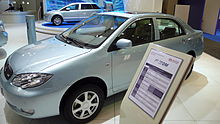 The Chinese BYD F3DM plug-in hybrid benefits from a 50,000 yuan (~US$7,634) subsidy paid directly to the carmaker.
The Chinese BYD F3DM plug-in hybrid benefits from a 50,000 yuan (~US$7,634) subsidy paid directly to the carmaker.
On June 1, 2010, the Chinese government announced a trial program to provide incentives up to 60,000 yuan (~US$9,281 in June 2011) for private purchase of new battery electric vehicles and 50,000 yuan (~US$7,634 in June 2011) for plug-in hybrids in five cities.[9][10] The cities participating in the pilot program are Shanghai, Shenzhen, Hangzhou, Hefei and Changchun. The subsidies are paid directly to automakers rather than consumers, but the government expects that vehicle prices will be reduced accordingly. The amount of the subsidy will be reduced once 50,000 units are sold.[9][10]
In addition to the subsidy, the Chinese government is planning to introduce, beginning on January 1, 2012, an exemption from annual taxes for pure electric, fuel-cell, and plug-in hybrid vehicles. Hybrid vehicles will be eligible for a 50% reduction only.[11]
Europe
As of April 2011, 15 of the 27 European Union member states provide tax incentives for electrically chargeable vehicles, which includes all Western European countries plus the Czech Republic and Romania. Also 17 countries levy carbon dioxide related taxes on passenger cars as a disincentive. The incentives consist of tax reductions and exemptions, as well as of bonus payments for buyers of PEVs, hybrid vehicles, and some alternative fuel vehicles.[12][13]
Austria
Electric vehicles are exempt from the fuel consumption tax, levied upon the first registration, and from the monthly vehicle tax. In addition to tax breaks, hybrid vehicles and other alternative fuel vehicles benefit from a fuel consumption tax that pays bonuses to passenger cars with low carbon dioxide output. Alternative fuel vehicles, including hybrids, qualify for as much as €800 (around US$1,120) in annual bonuses. This bonus is valid from 1 July 2008 until 31 August 2012.[12][13]
Belgium
The Belgian government established a personal income tax deduction of 30% of the purchase price including VAT of a new electric vehicle, up to €9,000. Plug-in hybrids are not eligible.[14][15][16] There is also available a tax deduction up to 40% for investments in external recharging stations publicly accessible, to a maximum of €250.[15] The Wallonia regional government has an additional €4,500 eco-bonus for cars registered before December 31, 2011.[17]
Czech Republic
Electric, hybrid and other alternative fuel vehicles used for business purposes are exempt from the road tax.[13]
Denmark
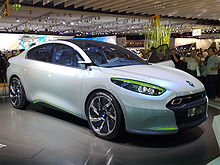 The Renault Fluence Z.E. will be launched in Denmark and Israel by late 2011 as part of the Better Place network.
The Renault Fluence Z.E. will be launched in Denmark and Israel by late 2011 as part of the Better Place network.
Electric vehicles weighing under 2,000 kg are exempt from the new car registration tax since 1985, but available models were so limited that by 2009 only 497 EVs are registered in the entire country.[16][18] The registration tax in Denmark is based on the vehicle's purchase price of the vehicle, and is set at 105% if the vehicle price is up to DKK79,000 (around US$13,250) and 180% if the price is above DKK79,000.[16] The government also grants free parking in downtown Copenhagen for EVS.[18] This exemption does not apply to hybrid electric vehicles.[16]
France
A premium, under a Bonus-Malus system, is granted in France up to €5,000 for the purchase of new cars with CO2 emissions of 60 gr/km or less which benefits all-electric cars and any plug-in hybrid with such low emissions. Vehicles emitting up to 125 gr/km or less, such as hybrids and natural gas vehicles, are granted up to €2,000.[16][19] The incentive cannot exceed 20% of the sales price including VAT, increased with the cost of the battery if it is rented. The incentive is available for purchases through 2012.[16]
Germany
Electric vehicles and plug-ins are exempt from the annual circulation tax for a period of five years from the date of their first registration.[16][20] In May 2010 the German government announced that it will not provide subsidies to the sales of electric cars but instead it will only fund research in the area of electric mobility.[21]
Greece
All electric and hybrid vehicles are exempt from the registration tax.[13]
Ireland
Ireland offers a government grant of €5,000 for the purchase of a new electric cars.[22] Also electric and hybrid vehicles benefit from a reduction of up to €2,500 of the registration tax. The latter benefit is valid until December 31, 2010.[16]
Italy
Electric vehicles are exempt from the annual circulation tax or ownership tax for five years from the date of their first registration. Thereafter, EVs benefit from a 75% reduction of the tax rate applied to equivalent gasoline-powered vehicles.[13]
Luxembourg
Buyers of electric vehicles and other vehicles emitting 60 g/km or less of carbon dioxide are eligible to receive a premium of €3,000 (around US$4,200) until 31 December 2011. In order to qualify for the rebate, the owner must have concluded an agreement to buy electricity from renewable energy.[12][13]
Netherlands
There are no direct purchase subsidies for electric vehicles, but other existing incentives include total exemption of the registration fee and road taxes, which result in savings of approximately €5,324 for private car owners over four years[13][23] and €19,000 for corporate owners over five years.[24] Other vehicles including hybrid vehicles are also exempt from these taxes if they emit less than 95 g/km for diesel-powered vehicles, or less than 110 g/km for gasoline-powered vehicles.[13]
Buyers will also have access to parking spaces in Amsterdam reserved for battery electric vehicles, so they will avoid the current wait for a parking place in Amsterdam, which can reach up to 10 years in some parts of the city.[25]
Norway
In Norway, all electric vehicles are exempt from all non-recurring vehicle fees, including sales tax. Electric vehicles are also exempt from the annual road tax, all public parking fees, and toll payments, as well as being able to use bus lanes.[26]
Portugal
Portugal established a government subsidy of €5,000 for the first 5,000 new electric cars sold in the country. In addition, there is in place a €1,500 incentive if the consumer turn in a used car as part of the down payment for the new electric car.[27] Electric cars are also exempt from the registration tax.[16]
Romania
Romania offers a government grant of up to 25% of the price (or max. €5,000) for the purchase of a new electric car.[28] Furthermore, through the cash-for-clunkers program (scrappage program), those who wish to purchase an electric car will receive six vouchers of over €5,000 (as of 2011) in return for their used car.[28]
Spain
In May 2011 the Spanish government approved a €72 million (US$103 million) fund for year 2011 to promote electric vehicles. The incentives include direct subsidies for the acquisition of new electric cars for up to 25% of the purchase price, before tax, to a maximum of €6,000 per vehicle (US$8,600), and 25% of the gross purchase price of other electric vehicles such as buses and vans, with a maximum of €15,000 or €30,000, depending on the range and type of vehicle.[29] Several regional government grant incentives for the purchase of alternative fuel vehicles including electric and hybrid vehicles. In Aragón, Asturias, Baleares, Madrid, Navarra, Valencia, Castilla-La Mancha, Murcia, Castilla y León electric vehicles are eligible to a €6,000 tax incentive and hybrids to €2,000.[16]
Sweden
In September 2011 the Swedish government approved a SEK 200 million program, effective starting in January 2012, that will provide subsidies for the purchase of electric cars and other "super green cars" with ultra-low carbon emissions (below 50 grams of carbon dioxide per km).[30]
There is also an exemption from the annual circulation tax for the first five years from the date of their first registration that benefits owners of electric vehicles with an energy consumption of 37 kWh per 100 km or less, and hybrid vehicles with CO2 emissions of 120 g/km or less. In addition, for both electric and hybrid vehicles, the taxable value of the car for the purposes of calculating the benefit in kind of a company car under personal income tax is reduced by 40% compared with the corresponding or comparable gasoline or diesel-powered car. The reduction of the taxable value has a cap of SEK 16,000 per year.[13]
United Kingdom
The Plug-in Car Grant started on 1 January 2011 and is available across the U.K. The program reduces the up-front cost of eligible cars by providing a 25% grant towards the cost of new plug-in cars capped at GB£5,000 (US$7,800). Both private and business fleet buyers are eligible for this grant which is received at the point of purchase. The subsidy programme is managed in a similar way to the grant made as part of the 2009 Car Scrappage Scheme, allowing consumers to buy an eligible car discounted at the point of purchase with the subsidy claimed back by the manufacturer afterwards.[31][32][33]
The Tesla Roadster is available in the U.K. but is not included on the government's plug-in electric car grant list of eligible vehicles.[34]
The scheme was first announced in January 2009 by the Labour Government. The coalition government, led by David Cameron, took office in May 2010 and confirmed their support of the grant on 28 July 2010. This confirmed that GB£43 million would be available for the first 15 months of the scheme, with the 2011 Spending Review confirming funding for the programme for the lifetime of the Parliament of around GB£300 million. The level of the consumer incentive will be reviewed at regular points, with the first in January 2012.[35][36][37]
Vehicles eligible for the subsidy must meet the following criteria:[32][38]
- Vehicle type: Only ultra-low emission cars are eligible (vehicle category M1). Motorbikes, quadricycles and vans are not covered.
- Carbon dioxide exhaust emissions: Vehicles must emit equal or less than 75 grams of carbon dioxide (CO2) per kilometre driven.
- Range: Electric vehicles (EVs) must be able to travel a minimum of 70 miles (110 km) between charges. Plug-in hybrid electric vehicles (PHEVs) must have a minimum all-electric range of 10 miles (16 km).
- Minimum top speed: Vehicles must be able to reach a speed of 60 miles per hour (97 km/h) or more.
- Warranty: Vehicles must have a 3-year or 60,000 miles (97,000 km) vehicle warranty (guarantee) and a 3-year battery and electric drive train warranty, with the option of extending the battery warranty for an extra 2 years(‘drive train’ means the parts that send power from the engine to the wheels. These include the clutch, transmission (gear box), drive shafts, U-joints and differential).
- Battery performance: Vehicles must have either a minimum 5-year warranty on the battery and electric drive train as standard , or extra evidence of battery performance to show reasonable performance after 3 years of use
- Electrical safety: Vehicles must comply with certain regulations (UN-ECE Reg 100.00) that show that they are electrically safe.
- Crash safety: To make sure cars will be safe in a crash, they must either have: EC whole vehicle type approval (EC WVTA, not small series) or evidence that the car has appropriate levels of safety as judged by international standards
As of July 2011 the following cars are eligible for the grant: Mitsubishi i-MiEV, Peugeot iOn, Citroen C-ZERO, Smart Fortwo electric drive, Nissan Leaf, Tata Vista, Vauxhall Ampera, Chevrolet Volt, Toyota Prius Plug-in Hybrid, and Renault Fluence ZE.[33] Despite meeting all the technical criteria for the grant and being available before the grant program started, the Tesla Roadster is not included on the government's plug-in electric car grant list of eligible vehicles. Tesla stated that the company applied for the scheme, but has not completed its application.[34]. As of 30 September 2011, 786 claims have been made through the Plug-In Car Grant scheme, with Society of Motor Manufacturers and Traders (SMMT) data showing that 910 cars eligible for the Grant were registered over the same period.[39]
Plugged-in Places
The Government is supporting the ‘Plugged-In Places’ programme to install vehicle recharging points across the UK. The scheme offers match-funding to consortia of businesses and public sector partners to support the installation of electric vehicle recharging infrastructure in lead places across the UK [40]. There are eight Plugged-In Places: East of England; Greater Manchester; London; the Midlands; Milton Keynes; North East; Northern Ireland and Scotland. The Government also published Making the Connection: the Plug-In Vehicle Infrastructure Strategy in June 2011.
Japan
The Japanese government introduced the first electric vehicle incentive program in 1996, and it was integrated in 1998 with the Clean Energy Vehicles Introduction Project, which provided subsidies and tax discounts for the purchase of electric, natural gas, methanol and hybrid electric vehicles. The project provided a purchase subsidy of up to 50% the incremental costs of a clean energy vehicle as compared with the price of a conventional engine vehicle.[41] This program was extended until 2003.[42]
In May 2009 the Japanese Diet passed the "Green Vehicle Purchasing Promotion Measure" that went into effect on June 19, 2009, but retroactive to April 10, 2009.[43] The program established tax deductions and exemptions for environmentally friendly and fuel efficient vehicles, according to a set of stipulated environmental performance criteria, and the requirements are applied equally to both foreign and domestically produced vehicles. The program provides purchasing subsidies for two type of cases, consumers purchasing a new passenger car without trade-in (non-replacement program), and for those consumers buying a new car trading an used car registered 13 years ago or earlier (scrappage program).[43][44]
Tonnage and acquisition tax reductions
New next generation vehicles, including electric and fuel cell vehicles, plug-in hybrids, hybrid electric vehicles, clean diesel and natural gas vehicles are exempted from both the acquisition tax and the tonnage tax. Other fuel efficient and low emission passenger cars, mini cars, and heavy-duty vehicles have a tax reduction that vary between 50 to 75% depending on the compliance of the new vehicle as compared to 2010 fuel efficiency standards and their improvement with respect to 2005 emissions standards.[44][46] Acquisition taxes on used vehicles will be reduced by 1.6% to 2.7%, or between 150,000 yen (~US$1,600) and 300,000 yen (~US$3,200). Electric and fuel cell vehicles have a 2.7% reduction while plug-in hybrids have a 2.4% reduction.[44][47]
These incentives are in effect from April 1, 2009 until March 31, 2012 for the acquisition tax which is paid once at the time of purchase. The tonnage tax reductions are in effect from April 1, 2009 until April 30, 2012 and the incentive is applicable once, at the time of the first mandatory inspection, three years after the vehicle purchase.[44][46] As an example, the amount exempted for the purchase of a new next generation vehicle is 81,000 yen (~US$975) corresponding to the acquisition tax, and 22,500 yen (~US$271) for the tonnage tax, for a total of 103,500 yen (~US$1,246).[44]
Automobile tax reductions
Consumers purchasing new next generation electric vehicles, including fuel cell, benefit of a 50% reduction of the annual automobile tax, and natural gas vehicles benefit only if their certified emissions are 75% down from 2005 standards. This incentives is in effect from April 1, 2009 until March 31, 2010, applicable only once.[44]
Incentives for purchasing new green vehicles
Subsidies for purchases of new environmentally friendly vehicles without scrapping a used car are 100,000 yen (~US$1,100) for the purchase of a standard or small car, and 50,000 yen (~US$550) for the purchase of a mini or kei vehicle. Subsidies for purchasing trucks and buses meeting the stipulated fuel efficiency and emission criteria vary between 200,000 yen (~US$2,100) to 900,000 yen (~US$9,600).[43][46][47]
Subsidies for purchases of new environmentally friendly vehicles in the case of owners scrapping a 13 year or older vehicle are 250,000 yen (~US$2,700) for the purchase of a standard or small car, and 125,000 yen (~US$1,300) for the purchase of a mini or kei vehicle. Subsidies for purchasing trucks and buses meeting the stipulated fuel efficiency and emission criteria vary between 400,000 yen (~US$4,300) to 1,800,000 yen (~US$19,000).[43][46][47]
All incentives for new purchases with or without trading were applicable in Japan's fiscal year 2009, from April 1, 2009 through March 31, 2010.[46][47]
United States
Federal government
Both the Chevrolet Volt and the Nissan Leaf are PEVs eligible for a U.S. federal tax credit up to US$7,500, and additional incentives in several states.First the Energy Improvement and Extension Act of 2008, and later the American Clean Energy and Security Act of 2009 (ACES) granted tax credits for new qualified plug-in electric drive motor vehicles.[48] The American Recovery and Reinvestment Act of 2009 (ARRA) also authorized federal tax credits for converted plug-ins, though the credit is lower than for new PEVs.[49]
New plug-in electric vehicles
As defined by the 2009 ACES Act, a PEV is a vehicle which draws propulsion energy from a traction battery with at least 5 kwh of capacity and uses an offboard source of energy to recharge such battery.[48] The tax credit for new plug-in electric vehicles is worth $2,500 plus $417 for each kilowatt-hour of battery capacity over 5 kwh, and the portion of the credit determined by battery capacity cannot exceed $5,000. Therefore, the total amount of the credit allowed for a new PEV is $7,500.[48]
The new qualified plug-in electric vehicle credit phases out for a PEV manufacturer over the one-year period beginning with the second calendar quarter after the calendar quarter in which at least 200,000 qualifying vehicles from that manufacturer have been sold for use in the United States. For this purpose cumulative sales are accounted after December 31, 2009. Qualifying PEVs are eligible for 50% of the credit if acquired in the first two quarters of the phase-out period, and 25% of the credit if bought in the third or fourth quarter of the phase-out period.[48] Both the Nissan Leaf electric vehicle and the Chevrolet Volt plug-in hybrid, launched in December 2010, are eligible for the maximum $7,500 tax credit.[50] The Toyota Prius Plug-in Hybrid, scheduled for 2012, is eligible for a $2,500 tax credit due to its smaller battery capacity of 5.2 kWh.[51]
Plug-in conversion kits
The 2009 ARRA provided a tax credit for plug-in electric drive conversion kits. The credit is equal to 10% of the cost of converting a vehicle to a qualified plug-in electric vehicle and in service after February 17, 2009. The maximum amount of the credit is $4,000. The credit does not apply to conversions made after December 31, 2011.[49][52]
Charging Equipment
There is a federal tax credit equal to 50% of the cost to buy and install a home-based charging station with a maximum credit of US$2,000 for each station. Businesses qualify for tax credits up to $50,000 for larger installations.[50][53] These credits expired on December 31, 2010, but were extended for one year with a reduced tax credit equal to 30% with a maximum credit of up to US$1,000 for each station for individuals and up to US$30,000 for commercial buyers.[54]
New proposals
Two separate initiatives are being pursued in 2011 to transform the tax credit into an instant cash rebate. The objective of both initiatives is to make new qualifying plug-in electric cars more accessible to buyers by making the incentive more effective. The rebate will be available at the point of sale allowing consumers to avoid a wait of up to a year to apply the tax credit against income tax returns.[55][56] The first initiative is from Senator Debbie Stabenow who reintroduced the "Charging America Forward Act." This bill was originally introduced in August 2010 but was not voted by the full Senate.[55] The bill will turn the tax credit into a rebate worth up to $7500 for plug-in electric vehicles and also provide businesses with a tax credit for purchasing medium or heavy duty plug-in hybrid trucks.[57] The other initiative is from the Obama Administration that was included in the submitted FY 2012 Budget as a provision to transform the existing credit into a rebate that will be claimable by dealers and passed along to the consumers.[56][58]
Another change to the law governing the plug-in tax credit was introduced by Senator Carl Levin and Representative Sander Levin who are proposing to raise the existing cap on the number of plug-in vehicles eligible for the tax credit. The proposal raises that limit from the existing 200,000 PEVs per manufacturer to 500,000 units.[55]
California
 The Tesla Roadster is eligible for a $7,500 federal tax credit and an additional $5,000 rebate in California.
The Tesla Roadster is eligible for a $7,500 federal tax credit and an additional $5,000 rebate in California.
The Clean Vehicle Rebate Project (CVRP), initially funded with a total of $4.1 million by the California Environmental Protection Agency’s Air Resources Board (ARB), was established in order to promote the production and use of zero-emission vehicles (ZEVs), including plug-in electric and fuel cell vehicles. The program was created from Assembly Bill 118 that was signed by Governor Schwarzenegger in October 2007. The funding will be provided on a first-come, first-served basis, and the project is expected to go through 2015.[59]
Eligible vehicles include only new ARB-certified or approved zero-emission or plug-in hybrid electric vehicles. Among the eligible vehicles are neighborhood electric vehicles, battery electric, plug-in hybrid electric, and fuel cell vehicles including cars, trucks, medium- and heavy-duty commercial vehicles, and zero-emission motorcycles. Vehicles must be purchased or leased on or after March 15, 2010. Rebates of up to $5,000 per light-duty vehicle are available for individuals and business owners who purchase or lease new eligible vehicles. Certain zero-emission commercial vehicles are also eligible for rebates up to $20,000.[59][60]
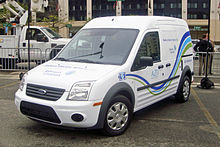 Besides the federal tax credit, the Ford Transit Connect Electric is eligible for an additional $4,000 rebate in California.
Besides the federal tax credit, the Ford Transit Connect Electric is eligible for an additional $4,000 rebate in California.
According to the Clean Vehicle Rebate Program a total of $1.4 million were distributed in 2010 for 213 plug-in vehicles that received the rebate, leaving $2.3 million available for 2011. In January 2011 the California Energy Commission (CEC) allocated a $2 million contribution for the program, and considering the $5 million coming in second year funding, funds available for the rebates will amount to $9.3 million in 2011. The additional $2 million provided by CEC are reserved for rebates of vehicles capable of carrying four passengers and highway driving, providing enough money for 400 more buyers of such plug-in vehicles to benefit from the program.[61] Once these funds were exhausted, the 2011-2012 program offered a lower rebate of up to $2,500. An additional $15 million was allocated for the 2011-2012 year program.[62] Current availability of CVRP funds can be checked on the California Center for Sustainable Energy web site.[63]
The 2011 Chevrolet Volt was not submitted for application to the Clean Vehicle Rebate Project rebate and therefore is not eligible for the $5,000 rebate. The reason is that the Volt does not meet the 10-year 150.000-mile (241.402 km) battery warranty requirement for partial zero-emissions vehicles (Enhanced AT-PZEV). The Volt team explained that for the launch GM decided to go with a common national package which includes an 8-year 100,000-mile (160,000 km) battery warranty. A configuration which qualifies for the CARB Enhanced AT-PZEV package is scheduled for the model year 2013, expected by mid 2012.[64][65]
Other states
Several states have established incentives and tax exemptions for BEVs and PHEVs, and other non-monetary incentives, as detailed in the following table:
State incentives for plug-in electric vehicles[66] State Amount of
incentiveType of
PEV/vehicleType of
incentiveCarpool lane
accessComments Arizona BEVs Lower licensing fees Yes Eligibility for PHEVs depends on the extent to which the vehicle is powered by electricity. California up to $2,500 BEVs Purchase rebate Yes Free access to HOVs through January, 1st, 2015, which also benefits material gas and hydrogenfuel cell vehicles.[67] up to $3,000 PHEVs Purchase rebate No PHEV access to HOV lanes pending approval in state legislature.[67] up to $1,500 Electric motorcycles
and NEVsPurchase rebate No Colorado up to $6,000 BEVs
and PHEVsIncome tax credit No Tax credit totaling 75 to 85% of the cost premium for a PEV purchase up to $6,000.
A 20% rebate also available for EV charger installation.[68]District of Columbia BEVs
and PHEVsExcise tax exemption and reduced registration fees n.a. Florida $5,000 PHEV
conversionLimited
conversion rebateYes In addition, EVs are exempt from most insurance surcharges. Georgia up to $5,000 BEVs Income tax credit Yes Tax credit of 20% of the cost of a zero emission vehicle up to $5,000.[69] up to $2,500 Alternative fuel
conversionIncome tax credit Yes Tax credit of 10% of the conversion cost for a vehicle converted to run solely on an alternative fuel and meets the standards for a low-emission vehicle up to $2,500. PHEVs not included.[69] Hawaii up to $5,000 BEVs
and PHEVsPurchase rebate n.a. Available for both PEV purchase and charging station costs. Up to $4,500 for vehicle only.[70] Illinois up to $4,000 BEVs, PHEVs
and conversionsState rebate No Covers 80% of cost premium or conversion price, up to $4,000. Louisiana up to $3,000 BEVs, PHEVs
and conversionsIncome tax credit No Tax credit of 50% of cost premium for BEV/PHEV purchase, 50% of conversion cost, or a tax credit worth 10% of the cost of a new BEV/PHEV vehicle up to $3,000. This same credit also applies to charge station costs. Montana up to $500 Alternative fuel conversion Income tax credit No Credit only available for conversion costs up to $500 or 50% of conversion cost. Includes electric car conversion.[71] New Jersey up to $4,000 BEVs Sales tax exemption Yes Exemption for qualifying BEVs only, not PHEVs. Rebates on BEV purchases also available for local governments. Oklahoma 50% cost BEVs, PHEVs
and conversionsIncome tax credit No Credit applies to either conversion cost or the cost premium of a new BEV purchase. For PHEVs, the credit is based on the portion of the vehicle attributable to propulsion by electricity. Tax credit also available for 75% of charge station cost. Oregon up to $5,000 PHEVs and conversions Income tax credit No Available for conversion or PHEV purchase costs only. up to $1,500 BEVs Income tax credit No Tax credit for purchase of or conversion to BEV. Pennsylvania up to $3,500 BEVs
and PHEVsPurchase rebate n.a. DEP will offer a $3,500 rebates for Plug-In Hybrid Electric Vehicles (PHEV) (battery 10 kWh or over) and Battery Electric Vehicle (EV) (battery under 10 kWh) to the first 500 qualified applicants. A $1000 rebate will be offered for any PHEV or EV (battery < 10 kWh). Additionally, $1000 rebates are available for Natural Gas fueled (CNG), Propane fueled (LPG) and Hydrogen and Fuel Cell vehicles (FC). A $500 rebate will be offered for Electric motorcycles/scooters (EMC). Rebate available up to 6-months after purchase. [72] South Carolina up to $1,500 BEVs
and PHEVsIncome tax credit No Tax credit equalling 20% of federal credits for PHEVs and BEVs. Tennessee $2,500 BEVs Tax rebate n.a. Only to the buyers of the first 1,000 electric vehicles sold in the state.[73] Utah up to $2,500 Conversions only Income tax credit Yes up to $750 BEVs
and PHEVsIncome tax credit Yes Washington BEVs
and PHEVsSales tax No BEVs are exempt from 6.5% sales tax and PHEVs exempt from the motor vehicle sales tax of 0.3%. Tax exemptions also apply to charge station parts and labor costs. Other states considering similar incentives are Connecticut, Massachusetts, New York, and Texas.[66]
See also
- Government incentives for fuel efficient vehicles in the United States
- Hybrid tax credit
- List of modern production plug-in electric vehicles
- Plug In America
References
- ^ a b c "Ontario Paves The Way For Electric Vehicles". Newsroom Ontario. 2010-06-18. http://www.news.ontario.ca/mto/en/2010/06/ontario-paves-the-way-for-electric-vehicles.html. Retrieved 2010-06-21.
- ^ "Which cars are eligible for Ontario's Electric Vehicle Incentive Program?". Ontario Ministry of Transportation. 2011-09-21. http://www.mto.gov.on.ca/english/dandv/vehicle/electric/ev-faq.shtml#incentive. Retrieved 2011-09-21.
- ^ John Loric (2009-07-15). "New Incentives for Electric Cars in Canada". New York Times. http://green.blogs.nytimes.com/2009/07/15/new-incentives-for-electric-cars-in-canada/. Retrieved 2010-06-05.
- ^ a b "Ontario gets new green licence plates". CBC News. 2009-11-21. http://www.cbc.ca/canada/ottawa/story/2009/11/02/ontario-green-licence-plates642.html. Retrieved 2010-06-05.
- ^ Eric Loveday (2011-04-11). "Quebec to offer plug-in vehicle rebates of up to C$8,000". AutoblogGreen. http://green.autoblog.com/2011/04/11/quebec-offer-plug-in-vehicle-rebates-8000-dollars/. Retrieved 2011-06-08.
- ^ "Running on Green Power! Electric Vehicles: 2011-2020 Québec Action Plan". Gouvernement du Québec. 2011. http://www.vehiculeselectriques.gouv.qc.ca/english/pdf/action-plan.pdf. Retrieved 2011-06-08. See Table Box 7 for the rebate details and how it changes by year.
- ^ "The Clean Energy Vehicle (CEV) Program". LiveSmart BC. 2011-11-05. http://www.livesmartbc.ca/incentives/transportation/. Retrieved 2011-11-13.
- ^ "Table 1 –Examples of Clean Energy Vehicles and Incentive Levels". LiveSmart BC. http://www.livesmartbc.ca/incentives/transportation/vehicle_incentives_list.pdf. Retrieved 2011-11-13.
- ^ a b "China Announces Plan to Subsidize EVs and Plug-in Hybrids in Five Major Cities". Edmunds.com. 2010-06-01. http://blogs.edmunds.com/greencaradvisor/2010/06/china-announces-plan-to-subsidize-evs-and-plug-in-hybrids-in-five-major-cities.html. Retrieved 2010-06-14.
- ^ a b Motavalli, Jim (2010-06-02). "China to Start Pilot Program, Providing Subsidies for Electric Cars and Hybrids". New York Times. http://wheels.blogs.nytimes.com/2010/06/02/china-to-start-pilot-program-providing-subsidies-for-electric-cars-and-hybrids/. Retrieved 2010-06-02.
- ^ Han Tianyang (2011-06-20). "Taxes slashed to cut emissions". China Daily. http://www.chinadaily.com.cn/cndy/2011-06/20/content_12731970.htm. Retrieved 2011-06-27.
- ^ a b c Paul Hockenos (2011-07-29). "Europe’s Incentive Plans for Spurring E.V. Sales". The New York Times. http://www.nytimes.com/2011/07/31/automobiles/europes-incentive-plans-for-spurring-ev-sales.html?_r=1&emc=eta1. Retrieved 2011-07-31.
- ^ a b c d e f g h i "Overview of Purchase and Tax Incentives for Electric Vehicles in the EU". European Automobile Manufacturers Association. 2011-03-14. http://www.acea.be/images/uploads/files/20110330_EV_tax_overview.pdf. Retrieved 2011-07-31.
- ^ "Incitants à l'achat de véhicules électriques en Belgique, Press Release". Going Electric. 2010-02-04. http://www.going-electric.org/vehicules-electriques/nouvelles/cp100203-avantages-financiers-belgique.htm. Retrieved 2011-06-11.
- ^ a b "Conseil des Ministres : nouvelles mesures éco-fiscales, Press Release" (in French). Ministre des Finances. 2009-11-20. http://minfin.fgov.be/portail2/fr/downloads/composition/ssp-environment-taxation-09-11-20.pdf. Retrieved 2010-05-24.
- ^ a b c d e f g h i j "Overview of Tax Incentives for Electric Vehicles in the EU". European Automobile Manufacturers Association. 2010-04-20. http://www.acea.be/images/uploads/files/20100420_EV_tax_overview.pdf. Retrieved 2010-05-18.
- ^ Eric Loveday (2011-06-11). "Nissan Leaf priced as low as €27,800* ($40,254 U.S.) in Belgium". AutoblogGreen. http://green.autoblog.com/2011/06/11/nissan-leaf-priced-as-low-as-27-800-40-254-u-s-in-belgium/. Retrieved 2011-06-11.
- ^ a b "In Denmark, Ambitious Plan for Electric Cars". New York Times. 2009-12-02. http://dealbook.blogs.nytimes.com/2009/12/02/in-denmark-ambitious-plan-for-electric-cars/?scp=1&sq=Denmark%20incentives%20electric%20car%20Better%20Place&st=cse. Retrieved 2010-05-26.
- ^ "50,000 Electric Vehicles: France Commits to Infrastructure & Production". ABC Carbon. 2010-04-13. http://abccarbon.com/50000-electric-vehicles-france-commits-to-infrastructure-production/. Retrieved 2010-05-24.
- ^ ACEA (February 2010). "Policy support for electrically chargeable vehicles". rai vereniging (RAI Association - Dutch Association of Bicycle and Automobile Industry). http://www.raivereniging.nl/dossiers/elektrische-voertuigen.aspx. Retrieved 2010-05-26. Click under "Overzicht stimuleringsprogrammas elektrische voertuigen (Overview incentive programs electric vehicles) to download the report in pdf format (website in Dutch).
- ^ John Blau (2010-05-03). "Berlin plugs in electric mobility strategy". Deutsche Welle. http://www.dw-world.de/dw/article/0,,5533192,00.html. Retrieved 2010-05-26.
- ^ "Ireland Moves To Ease Switch To Electric Cars With Grants, Infrastructure". Gas2.0. 2010-04-13. http://gas2.org/2010/04/13/ireland-moves-to-ease-switch-to-electric-cars-with-grants-infrastructure/. Retrieved 2010-05-17.
- ^ "Leaf prijzen" (in Dutch). Nissan Netherlands. http://www.nissan.nl/NL/nl/inside-nissan/innovation-and-technology/leaf_prijzen.html. Retrieved 2010-05-19.
- ^ Sam Abuelsamid (2010-05-17). "Nissan announces European prices for Leaf, under €30,000 after incentives". AutoblogGreen. http://green.autoblog.com/2010/05/17/nissan-announces-european-prices-for-leaf-under-30-000-after-i/. Retrieved 2010-05-19.
- ^ Graeme Roberts (2010-05-17). "UK: Nissan Leaf costlier in Europe even with incentives". Just-Auto. http://www.just-auto.com/news/nissan-leaf-costlier-in-europe-even-with-incentives_id104404.aspx?lk=dm. Retrieved 2010-05-17.
- ^ Lars Ole Valøen. "Electric Vehicle Policies in Norway". http://www.emc-mec.ca/files/Electric_Mobility_Canada_2008_open.pdf. Retrieved 2010-09-28.
- ^ "Nissan já divulgou preço do carro eléctrico Leaf" (in Portuguese). Journal de Notícias. 2010-05-17. http://jn.sapo.pt/blogs/velocidade/archive/2010/05/17/nissan-j-225-divulgou-pre-231-o-do-carro-el-233-ctrico-leaf.aspx. Retrieved 2010-05-17.
- ^ a b "Romanian Clunkers Program Available For Electric Car Buyers Starting Next Week". MediaFax. 2011-04-14. http://www.mediafax.ro/english/romanian-clunkers-program-available-for-electric-car-buyers-starting-next-week-8157168. Retrieved 2011-04-14.
- ^ "Government of Spain approves subsidies for purchase of electric vehicles". Green Car Congress. 2011-05-10. http://www.greencarcongress.com/2011/05/spain-20110510.html#more. Retrieved 2011-05-10.
- ^ Desk, Lifestyle (2011-09-08). "Sweden Follows Suit with Electric Car Subsidy". The Global Herald. http://theglobalherald.com/sweden-follows-suit-with-electric-car-subsidy/24444/. Retrieved 13 September 2011.
- ^ Paul Hudson (2010-02-28). "£5,000 grant to buy plug-in electric cars". London: The Daily Telegraph. http://www.telegraph.co.uk/motoring/green-motoring/7316351/5000-grant-to-buy-plug-in-electric-cars.html. Retrieved 2010-04-23.
- ^ a b "UK Government Announces £5,000 Grants Towards Purchase of Electric Drive Vehicles and First "Plugged-in Places"". Green Car Congress. 2010-02-26. http://www.greencarcongress.com/2010/02/uk-ev-20100226.html. Retrieved 2010-05-15.
- ^ a b "Plug-in car grant". Department for Transport. 2011-07-19. http://www.dft.gov.uk/topics/sustainable/olev/plug-in-car-grant/. Retrieved 2011-07-21.
- ^ a b "Why is the Tesla Roadster not on the government's electric car grant list?". The Guardian. 2010-12-14. http://www.guardian.co.uk/environment/blog/2010/dec/14/tesla-roadster-electric-car-list. Retrieved 2011-07-21.
- ^ "Green light to ultra low carbon car consumer incentive". Department for Transport. 2010-07-28. http://nds.coi.gov.uk/content/detail.aspx?NewsAreaId=2&ReleaseID=414706&SubjectId=16&AdvancedSearch=true. Retrieved 2011-07-21.
- ^ "Transport Secretary Philip Hammond confirmed today that motorists will receive up to £5,000 towards purchase of an ultra-low carbon car from January 2011". Department for Transport. 2010-07-28. http://nds.coi.gov.uk/content/Detail.aspx?ReleaseID=414706&NewsAreaID=2. Retrieved 2010-07-31.
- ^ Richard Scott (2010-07-27). "Electric car subsidy spared cuts by government". BBC News. http://www.bbc.co.uk/news/business-10783287. Retrieved 2011-07-21.
- ^ "Summary of the Plug-in Car Grant Eligibility Criteria". Department for Transport. http://assets.dft.gov.uk/eligibility-criteria-summary.pdf. Retrieved 2011-07-21.
- ^ http://www.dft.gov.uk/topics/sustainable/olev/plug-in-car-grant/
- ^ http://www.dft.gov.uk/topics/sustainable/olev/recharging-electric-vehicles/
- ^ "Incentives for EV & HEV". Electric Vehicle Association of Asia Pacific. October 2003. http://www.evaap.org/pdf/incentive.pdf. Retrieved 2010-06-06.
- ^ Max Ahman (2006-03). "Government policy and the development of electric vehicles in Japan". Energy Policy (34): 433–443. doi:10.1016/j.enpol.2004.06.011.
- ^ a b c d "Fact Sheet - Japanese Government Incentives for the Purchase of Environmentally Friendly Vehicles". Japan Automobile Manufacturers Association. http://jama.org/pdf/FactSheet10-2009-09-24.pdf. Retrieved 2010-12-24.
- ^ a b c d e f "The Motor Industry of Japan 2010". Japan Automobile Manufacturers Association. http://www.jama-english.jp/publications/MIJ2010.pdf. Retrieved 2010-12-24. See pages 45–46.
- ^ Yuri Kageyama (Associated Press) (2010-04-03). "Showrooms get i-MiEV, first cheap electric car". The Japan Times. http://search.japantimes.co.jp/cgi-bin/nb20100403a1.html. Retrieved 2010-06-06.
- ^ a b c d e "Japan's measures to withstand impact of global crisis on its automotive industry - JAMA shares at the 4th Indonesia International Automotive Conference". News from JAMA Asia (Japan Automobile Manufacturers Association) (36). September 2009. http://www.jama-english.jp/asia/news/2009/vol36/index.html. Retrieved 2010-06-06.
- ^ a b c d "Sales Promotion Scheme and 2009 Vehicle Sales Forecasts - Japan: Rebate for purchase or replacement with eco-friendly vehicles". Marklines.com. http://www.marklines.com/en/rinji/outlookfor2009_sales_en.jsp#japan. Retrieved 2010-06-06.
- ^ a b c d "Notice 2009-89: New Qualified Plug-in Electric Drive Motor Vehicle Credit". Internal Revenue Service. 2009-11-30. http://www.irs.gov/irb/2009-48_IRB/ar09.html. Retrieved 2010-04-01.
- ^ a b "Consumer Energy Tax Incentives: Plug-In Hybrid Conversion Kits". U.S. Department of Energy. http://www.energy.gov/taxbreaks.htm. Retrieved 2010-04-01.
- ^ a b "Nissan will sell electric car for just over $25K". Yahoo Finance. 2010-03-30. http://finance.yahoo.com/news/Nissans-electric-car-to-cost-apf-3270595876.html?x=0&sec=topStories&pos=6&asset=&ccode=. Retrieved 2010-03-30.
- ^ John Voelcker (2009-12-14). "Toyota Prius Plug-In Hybrid On Sale in 2011, Less Than $10K More". GreenCarReports.com. http://www.greencarreports.com/blog/1040132_toyota-prius-plug-in-hybrid-on-sale-in-2011-less-than-10k-more. Retrieved 2010-04-18.
- ^ "Energy Provisions of the American Recovery and Reinvestment Act of 2009: Conversion Kits". Internal Revenue Service. 2009-04-10. http://www.irs.gov/newsroom/article/0,,id=206871,00.html/. Retrieved 2010-04-01.
- ^ "US Tax Incentives for Plug-in Hybrids and Electric Cars". HybridCars.com. 2010-03-08. http://www.hybridcars.com/incentives-laws/us-tax-incentives-plug-hybrids-and-electric-cars.html. Retrieved 2010-01-04.
- ^ "Electric Car Charging Station Tax Credit Extended, But at Lower 30% Pre-Stimulus Levels". PluginCars.com. 2010-12-17. http://www.plugincars.com/breaking-electric-car-charging-station-tax-credit-extended-lower-30-pre-stimulus-levels-106580.html. Retrieved 2020-12-23.
- ^ a b c John Voelcker (2011-02-08). "Senator Stabenow: $7,500 Electric-Car Credit Should Be Rebate". GreenCarReports.com. http://www.greencarreports.com/blog/1055032_senator-stabenow-7500-electric-car-credit-should-be-rebate. Retrieved 2011-02-16.
- ^ a b "Obama FY 2012 budget proposes big boost for EVs and EV technology, cuts for hydrogen". Green Car Congress. 2011-02-14. http://www.greencarcongress.com/2011/02/budget-20110214.html#tp. Retrieved 2011-02-16.
- ^ "Charging America Forward Act to support Michigan-made vehicles". Stabenow.senate.gov. 2011-02-08. http://stabenow.senate.gov/?p=press_release&id=238.
- ^ Nick Chambers (2011-02-09). "White House Pushes For a $7,500 Instant Cash Rebate Towards Electric Car Purchases". PluginCars.com. http://www.plugincars.com/white-house-pushes-instant-7500-cash-rebate-towards-electric-car-purchases-106794.html. Retrieved 2011-02-16.
- ^ a b "Clean Vehicle Rebate Project". Center for Sustainable Energy. http://energycenter.org/index.php/incentive-programs/clean-vehicle-rebate-project. Retrieved 2010-04-01.
- ^ "CVRP Eligible Vehicles". Center for Sustainable Energy California. http://energycenter.org/index.php/incentive-programs/clean-vehicle-rebate-project/cvrp-eligible-vehicles. Retrieved 2010-06-08.
- ^ Brad Berman (2011-01-11). "California Energy Commission Adds $2 Million in EV Rebates, For Four-Passenger Cars Only". PluginCars.com. http://www.plugincars.com/california-energy-commission-adds-2-million-ev-rebates-four-passenger-cars-only-106666.html. Retrieved 2011-01-21.
- ^ "Clean Vehicle Rebate Project FAQ: Changes in CVRP FY 2011-2012". Center for Sustainable Energy California. https://energycenter.org/index.php/incentive-programs/clean-vehicle-rebate-project/frequently-asked-questions-cvrp#changes. Retrieved 2011-05-22.
- ^ "CVRP Program Status". Center for Sustainable Energy California. https://energycenter.org/index.php/incentive-programs/clean-vehicle-rebate-project/cvrp-program-status. Retrieved 2011-05-26.
- ^ "Chevrolet Volt MSRP Starts at $41,000, $33,500 Net of Full Federal Credit; 3-year Lease Program with Option to Buy". Green Car Congress. 2010-07-27. http://www.greencarcongress.com/2010/07/chevrolet-volt-msrp-starts-at-41000-33500-net-of-full-federal-credit-3year-lease-program-with-option.html#more. Retrieved 2010-07-27.
- ^ "Clean Vehicle Rebate Project General CVRP Questions: Why does the Chevrolet Volt NOT qualify this year?". Center for Sustainable Energy California. https://energycenter.org/index.php/incentive-programs/clean-vehicle-rebate-project/frequently-asked-questions-cvrp#general. Retrieved 2011-05-22.
- ^ a b "State and Federal Incentives for EVs, PHEVs and Charge Stations". Plug In America. http://action.pluginamerica.org/t/5960/content.jsp?content_KEY=5545. Retrieved 2010-05-29.
- ^ a b John Voelcker (2010-07-08). "California Yanks Prius Perks: No More Hybrid HOV-Lane Access". GreenCarReports.com. http://www.greencarreports.com/blog/1046928_california-yanks-prius-perks-no-more-hybrid-hov-lane-access. Retrieved 2010-07-09.
- ^ "RechargeColorado". 2011-09-30. http://rechargecolorado.com/index.php/programs_overview/energy_policy_and_legislation/motor_vehicle_incentives. Retrieved 2011-09-30.
- ^ a b "LEV/ZEV and Electric Vehicle Charger Tax Credit Fact Sheet". Georgia Department of Natural Resources. 2004-09-15. http://www.gaepd.org/Files_PDF/forms/apb/levzev_fs.pdf. Retrieved 2010-05-29.
- ^ "Hawaii's Electric Vehicle (EV) Rebate Program". http://hawaii.gov/dbedt/info/energy/evrebatesgrants/rebates. Retrieved 2010-08-16.
- ^ "Tax and Other Incentives - Montana Incentives for Renewable Energy". Montana Department of Environmental Quality. http://www.deq.mt.gov/Energy/renewable/taxincentrenew.mcpx#15-30-164. Retrieved 2010-05-30.
- ^ "Alternative Fuels Incentive Grant Program: Alternative Fuel Vehicle (AFV) Rebates". http://www.portal.state.pa.us/portal/server.pt/community/alternative_fuels_incentive_grant/10492/alternative_fuel_vehicles/553206. Retrieved 2011-09-30.
- ^ "Tennessee announces $2,500 electric car rebate". The Detroit News. 2010-09-09. http://detnews.com/article/20100908/AUTO01/9080443/1148/rss25. Retrieved 2010-09-09.
External links
- Clean Vehicle Rebate Project website
- Overview of Tax Incentives for Electrically Chargeable Vehicles in the E.U.
- U.S. Federal & State Incentives & Laws
- U.S. State and Federal Incentives for EVs, PHEVs and Charge Stations
- US Tax Incentives for Plug-in Hybrids and Electric Cars
- New Energy Tax Credits for Electric Vehicles purchased in 2009
- Plug-in Tracker: A comprehensive list of highway-capable PEVs (cars and trucks, 2- and 3-wheeled and commercial vehicles)
Categories:- Electric vehicles
- Plug-in hybrid vehicles
- Electric vehicle conversion
- Taxation in the United States
- Taxation in the United Kingdom
Wikimedia Foundation. 2010.

